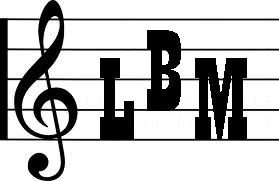Noticing Notes
(Week 14)
Hey guys! How's everyone doing? Today, I'm going to talk about reading musical notation and scores. So if you want to learn a little about what all the weird circles and lines and symbols on music scores are, you've come to the right place!
First things first! Below is a blank staff, or stave (plural: staves). The whole five lines (and four spaces) make up the staff, which is basically where all the musical notation is printed on.
At the beginning of every staff is a clef. The two most common are the treble and bass clef, shown above and on the right.
Musical notes lie on the staff, either on one of the five lines or in between the lines in one of the four spaces. Common musical notes look like this:
Ledger lines are extensions to the basic five-line staff to represent notes above or below the staff.
Music note pitches are represented by letters of the alphabet (from A to G) only.
Let's learn to read these notes and the pitch they represent on the staff, beginning with the treble clef.
Shown below is C, or more specifically, Middle C.
Moving up by one space or line at a time, the notes are read one alphabet at a time, shown below. An octave is the eight notes with increasing or decreasing pitches, one after the other. Below, C to C is a full octave.
Above shows the note pitches (alphabets) in relation to the treble clef. Notes on the base clef are shown below. Middle C on the base clef is the rightmost note shown below. This means that the leftmost note in the picture above (treble clef picture) is actually of the same pitch as the rightmost note shown below. Both are known as Middle C.
On the piano, when you press the corresponding key, you get the note's sound. When you press the next white key, you get the sound of the next alphabet, and so on.
Basically, Middle C on the piano is literally in the middle of the piano. If you look carefully at the piano keys in the picture above, the keys with the same alphabets look the same, and they are all an octave apart. So just look for the C piano key that is the most centralized on a piano, and you have found Middle C. In case you still have no idea if you have got the right key or not, click here (
Middle-C Sound) to play the audio for Middle C (just listen to the first few seconds of the video), and if it sounds the same as the key you are playing, you have found Middle C! (:
This is just a short guide on how to read musical notes. Of course, I haven't covered several other things, like the note timings, rests, sharps, flats, key signatures, time signatures, etc. as this is a huge topic. I hope you've enjoyed this post and perhaps learned a little something about noticing notes! You can learn some simple songs on the piano on your own now, with this basic knowledge under your belt!
Do share this with your other friends who want to learn quickly about the basics of reading musical notes (yes, I know its extremely basic!). Do you want to see a follow up which covers this more comprehensively? What other kinds of posts do you want to see? Please leave your feedback and comments here, and also leave your footprint in the tagboard above!
Have a great day!
References:
- http://library.thinkquest.org/15413/theory/note-reading.htm
- http://sheerenchantment.co.uk/wp-content/pageflip/upload/bass-clef-treble-clef-heart-679.jpg














Post a Comment
Welcome to LBM!
Kindly drop a comment and show us some support!
Thank you.